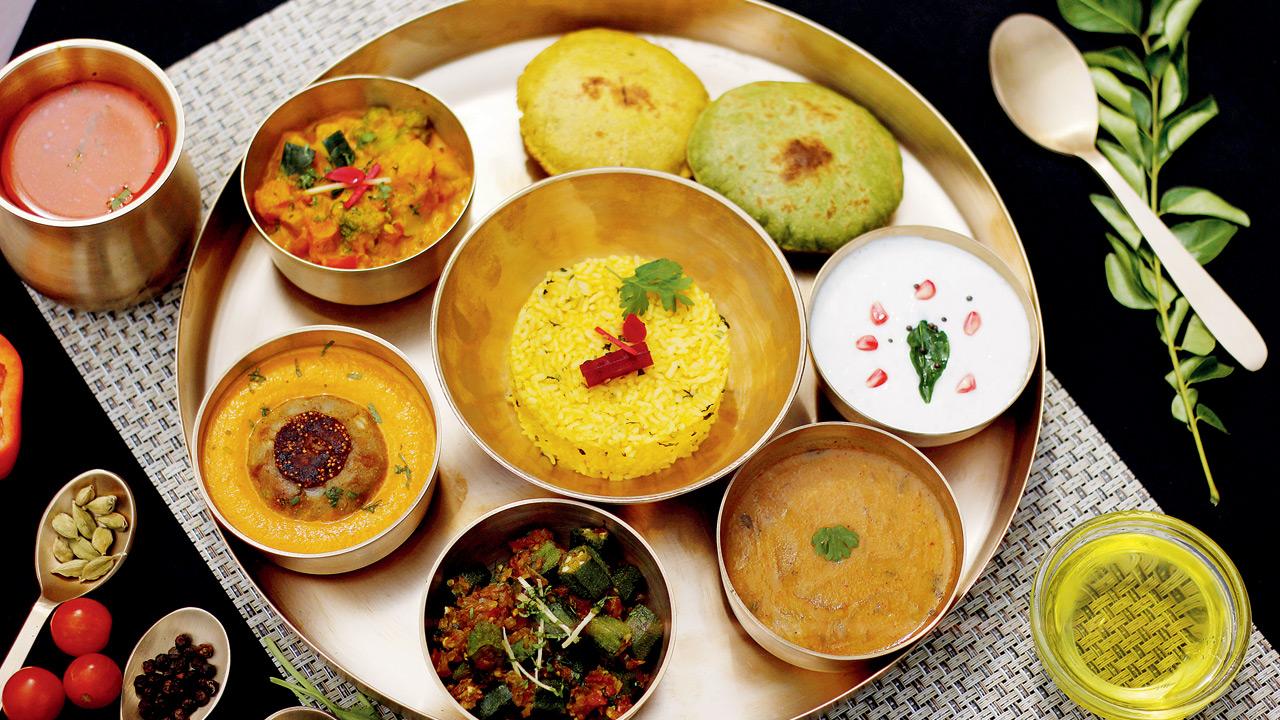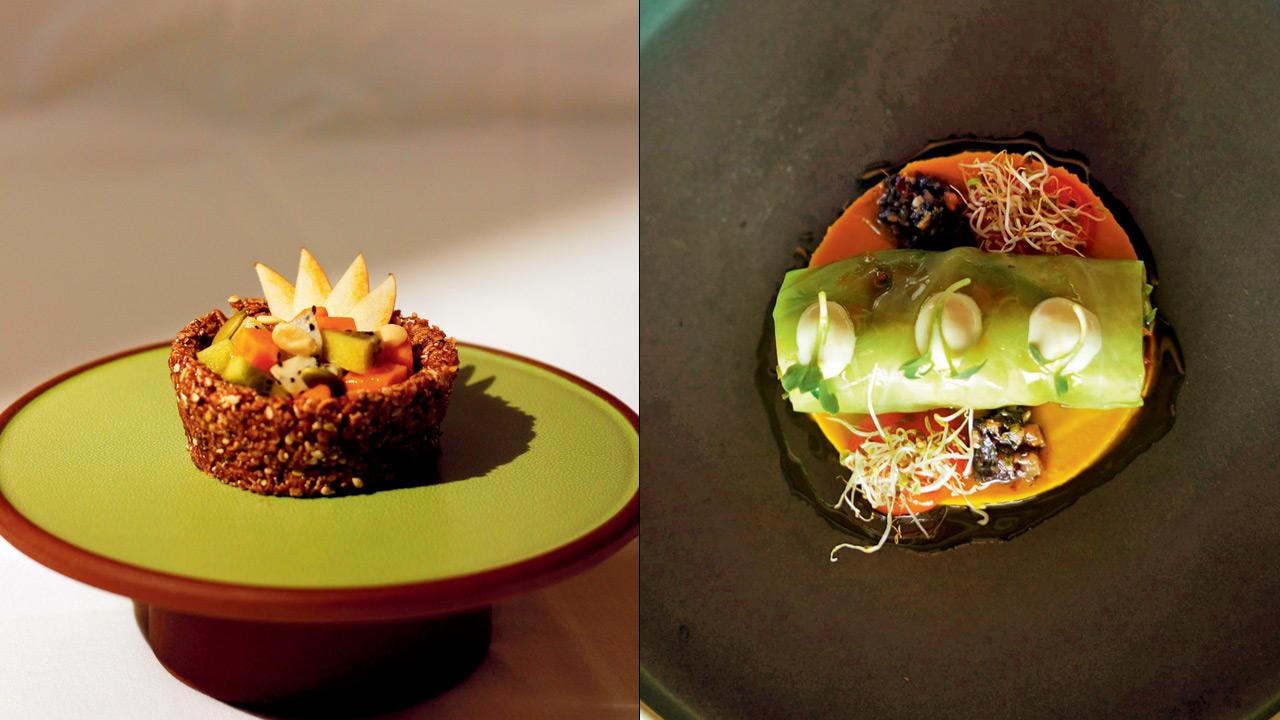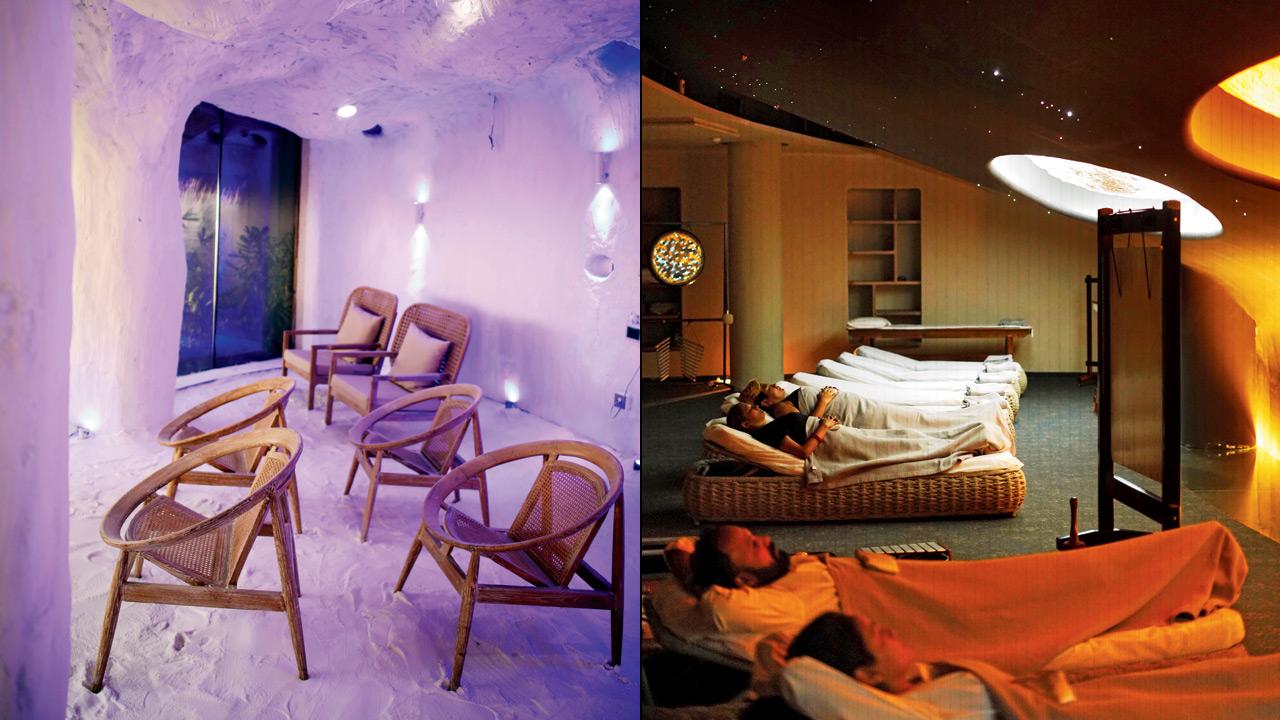Would you travel for a White Lotus-esque retreat on the outskirts of Pune?

The Sukh Vihar section in Swastik Wellbeing looks like it lives up to the name
As the car halts at the gate of Swastik Wellbeing, your wellness journey begins in seconds. Shoes off, feet washed, you stand in a metal bowl and are asked to ring the giant brass bell overhead while a staff member rings the bowl. “Feel the vibrations and cleanse your energy,” we are told. The staffer welcomes us to the reception area with an “Atmanaman”. Over the next three days, every staff member we encounter greets us with the word, which means “bowing to you with my soul”.
A few steps up into the lobby, and the pace of the outside world begins to fall away. The view stretches across the quiet Peacock Valley, complete with the glint of the Khadakwasla river, and the distant rooftops of the NDA campus. At the centre of the resort’s activities and the view, the Dhyan Mandir, Swastik’s meditation dome, sits framed by the forest.

The Ayurvedic thali at the retreat
Set in Khadakwasla in Pune district, Swastik isn’t a resort in the traditional sense. It’s a wellness campus built around Ayurvedic principles. The space is designed for rest, but not leisure. Swastik’s founder, Dr Niting Nyati, is not shy about ambition. An artificial river is under construction, designed to host a Ganga-style aarti every evening. “We want guests to feel what they would in Rishikesh or Kashi,” a staff member explains. Structure anchors everything here, from meals and therapies to wake-up calls and bedtime routines.
Mornings begin at 5.30 am, marked by a soft chant playing through hidden speakers. The rest of the day moves with quiet rhythm: sunrise yoga, Ayurvedic meals, doctor consultations, and therapies like halotherapy, aqua yoga, mud packs, and sound healing. There is a flute perpetually playing from the speakers no matter which part of the resort you’re walking around. The only indulgence you can seek is a cup of herbal tea. But that too feels scheduled, as it’s always after a massage therapy.

Baked fruit tart and Chlorophyll roll
The day continues in quiet rhythm: a nutrition-rich breakfast, followed by Ayurvedic doctor consultations, therapies, and blocks of rest. Each guest is assigned a personalised schedule based on private consultations with doctors and a diagnostic analysis.
The therapies include a mix of traditional and modern treatments: halotherapy in a room lined from ceiling to floor with salt imported from Poland, aqua yoga in the pool, mud therapy, steam chambers, hot and cold plunges, and full-body oil massages. There are also reflexology walks, forest bathing trails, and sound healing sessions throughout the day.
Phones are discouraged, and there is little room for digital interruption. For some, the structure can feel rigid; for others, it’s a relief. Noor, a guest visiting from Dubai, says, “I just wanted to come to Pune. This place looked great in photos and it seemed new-age, so I decided to show up.” She was unable to book her stay, she says, but took a flight regardless and asked for a room. To her luck, one was available.
The campus is spread across 14 acres and divided into different zones, and each is designed by Manish Banker, the head of architecture and founder of TAOStudiO, with a purpose. Dhyan Vihar is the heart of meditative activity, with the dome-shaped Dhyan Mandir sitting at its centre. Ayu Vihar houses the therapy rooms, with a thatched roof, the kind you would expect to see at a wellness resort in Thailand. Sukh Vihar is where the residential villas are located, rows of cream-toned hobbit homes with arched doorways, balconies, and roofs all wrapped in vines, with wooden swings that open into green gardens. Anand Vihar adds a touch of lightness with its pool, rooms for more relaxed activities like breathwork, sound healing therapy, an aerial yoga studio, and pebble painting.

Halotherapy at the retreat and The Ninadika therapy
The healing process at Swastik begins with a detailed intake consultation. Each guest meets an Ayurvedic doctor, who spends time discussing current imbalances, lifestyle, and symptoms, both physical and emotional. Skin, sleep cycles, digestive patterns, and energy levels—everything is discussed. The questions are expansive, and designed to be able to recommend the right therapies or even a diet if one needs it.
Based on these insights, a personalised plan is drawn up, one that includes a daily schedule of therapies, yoga sessions, movement, and even meals in some cases. “The idea is not to treat symptoms in isolation,” says Swastik’s wellness director Dr Milind Salunkhe, one night over dinner. “In Ayurveda, we try to understand the patterns behind them, how a person’s body and mind are interacting with their environment, and where the dissonance is,” he says, explaining that it is key to know the doshas in Ayurveda and treat them accordingly.
The therapies themselves are carefully sequenced. Some are designed to detox and release, others to nourish and restore. On any given day, a guest may experience two to three sessions ranging from abhyanga (warm oil massage) to halotherapy. The massage therapists explain treatment in detail before it begins, if asked, and they are well-trained, careful, and determined to help you relax in the setting.
The food is one of the more surprising elements of the experience. Designed in tandem with Ayurvedic principles, the kitchen follows strict satvik dietary guidelines: no onion, garlic, refined sugar, or caffeine. But the meals are anything but bland. Instead, they arrive as plated artworks, course by course and are equal parts colourful, inventive, and satisfying. “We want guests to experience satvik food in a unique way, with ample variety,” explains executive chef Arvind Joshi. Each day, the menu changes with each meal and celebrates vegetables beautifully—whether it’s the savoury broccoli cake, baked medu vada and sambar, beetroot tortellini, the carrot-orange soup, or flaxseed tacos filled with avocado, sautéed vegetables, and microgreens, or the chef-recommended chlorophyll roll, which is a roll of veggies wrapped in a cabbage leaf and served with a drizzle of jus. Even the desserts, although crafted to be healthy, hold a kind of indulgence, like a tomato halwa that echoes the flavour of gajar ka halwa, which the sceptic in us refuses to believe was made using tomatoes.
The kitchen runs like clockwork, but at times the service feels excruciatingly slow. Each meal, before it’s served, begins with a prayer played through a speaker placed on your table. And it ends with a digestive shot created with the likes of ginger. You might miss your daily cup of tea or coffee, but that quickly fades away as the body adjusts to the new rhythm.
There’s a noticeable contrast between the Ayurvedic foundation of Swastik and its global design sensibility. Therapy rooms use white linen and wood, and the overall aesthetic recalls wellness spaces in Bali or Tulum. A trip to Swastik is rooted in Indian healing traditions but accessible to a contemporary, global audience. It’s not overtly spiritual, and the stillness is designed, but the surroundings add to its calm.
 Subscribe today by clicking the link and stay updated with the latest news!" Click here!
Subscribe today by clicking the link and stay updated with the latest news!" Click here!








